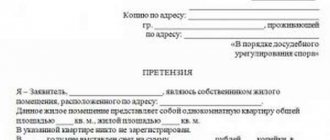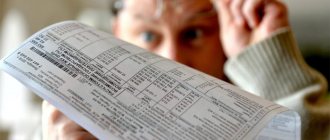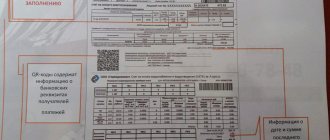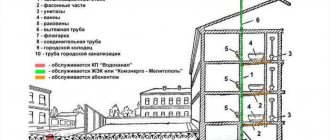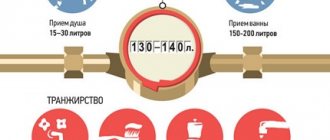Housing and communal services are written down in an abbreviated form in the payment receipt. It is not always clear what exactly is meant by this or that column.
Each region has its own forms of receipts. But at the state level, all housing and communal services are regulated by a number of legislative acts. It is these acts that set the upper limit for tariffs, beyond which regional authorities cannot go. The price of water supply will depend on a number of factors. These will also include the availability of water resources, their volume, and the suitability of the water for consumption, because there is a possibility of additional disinfection actions.
How are payments for cold water calculated?
Payment for cold water supply is calculated in several ways.
According to the standard
If a house or apartment is not equipped with metering devices, charges for the use of cold water are calculated based on the tariffs established in the region and the calculated cold water standards per person. To find out what the standard and tariff are in a particular locality, you need to contact the management company or the consumer department of the city water utility. You can also get the necessary information on the official website “State Information Systems”, as well as on the portal of city authorities.
According to the standards, payment is calculated if:
- counters are not installed. Availability of equipment is mandatory. If the homeowner refuses installation and cannot document the technical impossibility of installation, the payment will be calculated according to the standards, but with an increasing factor (1.5);
- if apartments or houses have individual metering devices, but the owners do not provide meter readings within three months (increasing factors are not applied);
- if the meter has not passed mandatory verification or has broken down.
The final amount depends on the number of registered residents.
Important! The Criminal Code has the right to check the compliance of actually living and registered citizens. If there are more people living, payment will be calculated based on this.
To check for yourself whether the amount on your receipt is correct, use the following formula:
Pvs = k*N*T
- Pvs is the amount of payment for cold water,
- k – number of residents,
- N – norm (in cubic meters),
- T – tariff.
If a multiplying factor is applied, the final amount will be one and a half times greater.
Calculation using metering devices
If all the necessary metering devices are installed in an apartment or house, it is much easier to control the accrual of payments. Meters for cold and hot water are often installed side by side, it is important to take this into account. IPU HVS has a blue body. The readings must be taken by the 25th of the current month. The number of cubic meters used is recorded; leading zeros and fractional digits are not indicated.
You need to subtract the previous indicators from the resulting indicator and multiply the difference by the tariff.
Important! Meters with overdue mandatory verification are considered invalid and their indicators are not taken into account.
Making payments according to meter readings is much more profitable, especially if, for example, 4 people are registered in an apartment, but in fact there are only two people living in it.
Calculation by KPU
Another method of charging for the use of cold water is the HVS KPU. To many this sounds like gobbledygook. In the HVS receipt, the KPU is the amount that is calculated for the consumption of cold water according to collective metering devices. Nowadays, in all new buildings, and in many houses that have been put into operation for a long time, collective metering devices are installed.
If a KPU is installed on a house, its indicators are divided equally between the total number of residents. If individual metering devices are installed in the apartments, individual meters are subtracted from the general KPU readings, and the remaining cubic meters are divided into those apartments where there are no meters (again, according to the number of registered citizens).
What is the essence of the concept of water disposal, decoding of DPU and KPU in the receipt
The service provider’s task is to provide apartments with a utility resource of appropriate quality.
Sometimes the heating network justifies poor-quality service provision by the deplorable state of the networks - routes built in the last century that require major repairs will not withstand temperature changes in winter if the parameters of the coolant at the exit from the boiler room are maintained at the standard level.
Example. A Moscow family of 2 people bought a new building with a mortgage and did not have time to install individual meters in it. Accordingly, it pays for the use and disposal of water according to standards multiplied by the increasing coefficient and the number of registered ones. Thus, the cost of wastewater disposal will be 11.68 * 2 * 25.12 * 1.5 = 880.20 rubles.
What is cold water on SOI?
SOI is the maintenance of the common property of apartment buildings. Cold water can be used for cleaning entrances, elevators, washing communication systems, watering lawns, etc.
If a collective metering device for cold water supply is installed in the house, then the sum of all IPU readings is subtracted from the indicator taken, and the remaining number is divided by the number of residents. If the KPU is not installed, payment is calculated according to the tariff. The amount depends on the category of the premises and the area of common areas.
The decision to make payment after the fact is made at a general meeting of residents. In any case, if you pay for actual water use, costs will be lower, so it is recommended to install collective metering devices in all houses.
Components of the cost of hot water supply
On the territory of the Russian Federation in apartment buildings, cold and hot water supply is paid separately. The full cost of hot water supply includes several components:
- Thermal energy expended to heat cold water. For heating, boiler systems are used to supply hot water to centralized heating and water supply systems. Boiler houses use various types of fuel for heating. Depending on the availability of energy in a certain region of the Russian Federation, the price of thermal energy may differ.
- Chemicals. Before being supplied to the boiler and water supply and heating systems, the water passes through preparation equipment. This allows you to reduce its hardness and reduce the degree of negative impact of water on the materials from which boiler equipment is made.
- Maintenance and repair of boiler units. The organization supplying hot water may include in its cost the costs of repair work and maintenance of boiler equipment.
- Delivery of water to apartments. The liquid is supplied using specialized pumps powered by electricity. The cost of water delivery can be included in the full cost of hot water supply.
- Heat loss. When hot water is delivered through pipelines, a certain amount of heat is lost. To reduce this indicator, it is necessary to insulate the hot water supply riser. The procedure may require gating the walls in the apartment.
What is cold water heating for domestic hot water?
It’s worth saying right away that if the house has a centralized hot water supply, then additional heating is not provided, which means there should not be a line for hot water supply in the payment bill. To independently calculate the cost, you need to proceed from the standards and tariff. Heating cold water for hot water supply needs is 0.22 Gcal. According to the standards, 3.6 m3 is used per person per month, when the water is heated to 75 degrees. The number of residents must be multiplied by 1458.4 rubles/Gcal.
If there are hot water meters, the indicators are multiplied by 0.0611 and the tariff cost of 1 Gcal in your region.
Legislative regulation of the issue
The last important change in this area was the introduction of a two-tier tariff in 2013. It was since then that people began to pay for hot water supply both for cold water and its heating component. This regulatory act is Government Decree No. 406 of May 13, 2013. The document is constantly changing. The latest amendments were adopted in October 2019. Based on the resolution, a thermal energy component for water heating appeared in receipts. This made the payment more transparent.
How to reduce the cost of paying for cold water supply?
Many citizens approach the payment of utility bills not only responsibly, but also try to save money. To pay less for cold water supply you need to:
- supply individual metering devices;
- if this is not possible, and in fact there are fewer people living in the apartment than registered, you can submit an application to the Criminal Code for a recalculation;
- If there are constant problems with water pressure, you can also reduce the level of payment. The standard cold water pressure in an apartment building should be 0.03-0.6 MPa. If the pressure is less than 25% or less, the amount of payment should be reduced by 0.10%;
- if the pressure differs from the standard by more than 25%, the payment is reduced, recalculation is carried out based on the total accrual for each day.
In any case, you should remember that you need to pay for the HVS and transfer testimony regularly, this will help to avoid penalties and fines.
Metering device for cold water supply
The metering device is installed by the owner during the operation of the property. Registration is carried out in his name. The installation process is recorded in documents. They indicate the name of the housing and communal services organization that installed the meter, as well as the date of installation and the price for the work performed.
In 2021, using a meter is optional. But it should be installed for reasons of reducing utility costs.
The amount accrued to the HVS KPU account is carried out according to the readings of the registered meter. The device provides individual calculation of cold water.
According to the rules for the provision of public services, prescribed in Government Decree No. 354, the meter is installed by specialists based on an application from the homeowner. The meter has a technical passport.
Payment is proposed to be made according to the numerical values of the indicators of this device. It is necessary to take readings on the day of payment and indicate them when paying using your personal account.
Rules for installing the meter
The rules for using the meter are described in SNiP 2.04.01-85.
Servicing has the right to be carried out by a representative of the housing and communal services service. He records every action with the mechanisms or technological functionality of the meter in documents.
Important! The counter is sealed. Any independent manipulation of the meter is considered illegal.
Meter checks are provided. It is being implemented according to the plan prescribed in paragraph No. 80 (1) of Government Resolution No. 354. Only representatives of the housing and communal services service have the right to check, take readings from the scoreboard and record them in special documents.
Payment is proposed to be made according to the numerical values of the indicators of this device. It is necessary to take readings on the day of payment and indicate them when paying using your personal account.
Quality and heating of hot water
SanPiN clearly indicates the possible limits that must be observed in water collection areas and which cannot be ignored when using hot water heating. The heat supply system used does not in any way affect the temperature standards.
Main heat losses at home
After all, they are established according to epidemiological safety requirements and are aimed at preventing the incidence and spread of infections. For example, skin, contagious, viral and bacterial. The lower standard for heating is at least +60 °C, the upper standard can reach +75 °C.
Quality control rules and heating standards are recorded in the relevant SanPiN clauses. These rules are mandatory when paying for housing and communal services in the Russian Federation.
According to existing clauses, if water heating does not meet standards, the consumer has the right to demand a payment reduction of 0.1% for every three degrees. If the supplied water temperature is below +40 °C, then it is paid for as cold.
Energy accounting
The consumer has the right to demand quality control even in the case where the water contains foreign impurities of any origin, if their presence is systematic.
The standards and quality requirements for providing the population with hot water have not changed either in 2021 or this year, 2022. However, it is planned that next year, 2022, a two-component tariff for water payments will be introduced everywhere.
Water disposal
The fee for sewerage includes not only the direct drainage of water; in fact, it includes several services at once:
- drainage of domestic wastewater around the clock, that is, the same sewer system;
- their transportation within the boundaries of a populated area;
- further transportation outside the populated area.
Thus, the payment for sewerage means that the wastewater will not pollute the settlement in which you live - it is for work in this direction that it is charged.
Difference between drainage and sewerage
You can often come across the opinion that sewerage is the same as sewerage. But this is not so, and to make sure of this, let’s look at the differences between them. If drainage involves directly removing wastewater from a home and then transporting it, then sewerage involves, in addition to removing wastewater from the premises, also its subsequent cleaning and disinfection in order to later be used for technical purposes or returned to the reservoir.
This means that sewer fees mean that the wastewater will be treated and conditioned, and ultimately returned to the ecosystem. For the operation of all the systems required for this, funds contributed by consumers are needed, and the purity of the water, which will then be used again for water supply, is determined by how well the complex of treatment facilities functions.
But the concepts of drainage and sewerage are confused, and sometimes even considered synonymous, for a reason: they have a lot in common. First of all, this relates to the removal from the premises in which the water was used, its further disposal both inside the house and outside it, and then to further transportation - all this will be done the same in both cases.
Legality of accrual
Payment for housing and communal services is regulated by Decree of the Government of the Russian Federation No. 354. This legislative act was adopted in 2013 and contains a list of clarifying rules on how to pay for housing and communal services.
According to the Resolution, residents who live in houses with central heating pay for hot water supply at a two-part tariff.
It includes the following items:
- "Innings". Cold water is supplied to the house and enters the common house boiler.
- "Heat". The cold water in the boiler is heated to the required temperature and supplied to consumers.
The government adopted this legislation because there is a loss of heat energy in homes. Heating risers in residential premises consume heat, which was not previously taken into account when paying for utilities.
Thus, a way out of the current situation was found, and Russian citizens now pay for heating at a two-part tariff.
